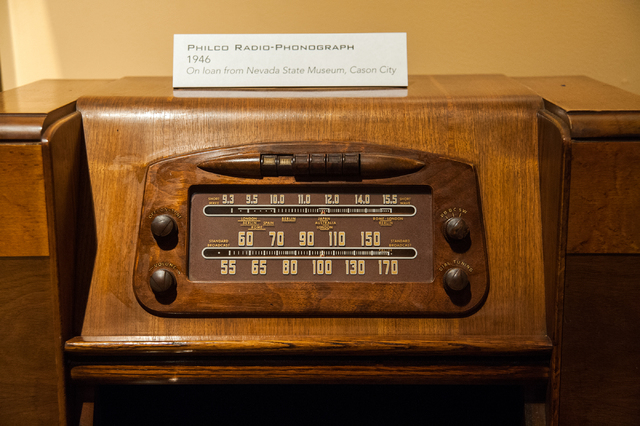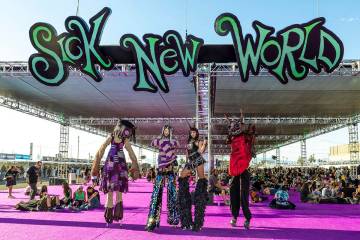Nevada State Museum exhibit revisits past technology
Even before the Silver State was a state, Nevada was high-tech.
But we’ve come a long way since the “Victorian Internet” that transmitted the Nevada constitution to Washington, D.C., so Nevada could join the Union.
The chance to see how far technology has taken Nevada — from petroglyphs to the Pony Express to smartphones — is as close as the Nevada State Museum, Las Vegas, at Springs Preserve.
“Every Age Is an Information Age,” on display until next May, may be timed to commemorate Nevada’s official Sesquicentennial celebration Oct. 31.
But that’s hardly on the minds of young museum visitors who stampede into the exhibit one morning — and make a beeline for a curious metal-and-glass structure, once ubiquitous, that most have never seen before.
“I wanna go in here!” one little girl enthuses before pausing to ponder that she has no idea how to get inside — until an older visitor pushes on a folding glass door, opening a 1950s telephone booth that includes instructions on how to “drop a dime” and make a call.
There’s no dime needed, however, as 5-year-old Trenton Warren discovers when he picks up the receiver to hear a stentorian voice intone these words: “Faster than a speeding bullet! More powerful than a locomotive. Able to leap tall buildings in a single bound. Look! Up in the sky! It’s a bird! It’s a plane! It’s Superman!”
Trenton’s too little to have heard those words launch every episode of the 1950s “Adventures of Superman” TV series — and watch Superman emerge from a phone booth just like this one.
Other youngsters eagerly duck under a black cloth to look through the lens of a camera obscura, test their penmanship with slate and chalk and tap out words on a manual typewriter. (One of the typewriters on display, a 1960s-era Olivetti Lettera 22, once belonged to former Review-Journal city editor Roy Vanett.)
There’s even a telegraph key to tap, connecting visitors with the 19th-century technology that helped Nevada become a state.
In 1864, President Abraham Lincoln was eager to proclaim Nevada’s statehood — in part to help his re-election, in part because he wanted more votes to ensure passage of the 13th Amendment to the U.S. Constitution, which abolished slavery, according to exhibit curator Crystal Van Dee.
But traditional mail-and-sail methods of getting the proposed Nevada constitution to Washington, D.C., for federal approval would have taken too long, she explains.
So, on Oct. 26, 1864, telegraphers coded the Nevada constitution and transmitted all 175 telegraphed pages of it — first to Salt Lake City, then to Chicago, Philadelphia and finally Washington, D.C. — on “the singing wire.” (The 12-hour transmission cost $4,403.27 — $59,230 in 2014 dollars.)
“It was such a big deal,” Van Dee notes, that officials in Washington “suspended all telegraph traffic to the War Department” for those 12 hours — despite the ongoing Civil War.
The New York Times reported the news under the headline “The New State of Nevada,” but that front page is only one of dozens featured on a newspaper wall recalling everything from the bombing of Pearl Harbor to the implosion of the Landmark hotel-casino.
A handwritten letter from Las Vegas-born Barbara Gates, serving in the Philippines during World War II, offers a personal perspective on the headlines when she writes to her parents following the dropping of the first atomic bomb on Hiroshima, Japan.
“Dear Mother and Dad — it is a strange night and one to remember,” the letter begins. “Starlight and lightning — an occasional red flare — stark skeletons of trees.” Gates’ letter continues, referring to “lilting music from the radio,” along with “excited chatter of peace” and “sudden hush during a newscast. Since Hiroshima, the atomic bomb has been the center of thought and conversation.”
Not everything featured in the exhibit is quite so momentous, however.
The telephones on display — from candlestick models to an operator switchboard that handled local calls until dial telephone service arrived in Las Vegas in 1955 — also chart the evolution of the cellular phone, from blackboard-eraser size to “my boss’ old flip phone,” Van Dee notes. “She’s a little embarrassed by it.”
A reproduction of a 1950s advertisement touts the latest in telephone technology: an automated busy signal. And on the newspaper wall, another ad urges readers to “GO BIG SCREEN” by purchasing a new General Electric portable television set with a 22-inch diagonal picture.
In the Digital Age area, a computer about 4 feet tall — approximately the same size as an old crank-powered record player, displayed on the opposite wall, from the early 20th century — qualifies as “one of our prize artifacts,” Van Dee observes.
It’s a 1980 Hazeltine computer (with 8-inch floppy disc drive) that Nevada officials purchased for the state museum in Carson City. It cost $40,000 then — and “the curators didn’t know how to use it,” she notes. “All those motherboards. The iPhone in my pocket is more powerful.”
Photographic equipment on display ranges from the 19th-century camera obscura to various Kodak and Polaroid cameras.
A panoramic photo showing Tonopah in its 1910s boom-town glory — taken with a special camera — stretches out on one wall, adjacent to another panoramic shot of 2013 Tonopah taken with an iPhone. (In both photographs, the Mizpah Hotel stands out as a dominant landmark.)
Another exhibit showcases various made-in-Nevada movies, including lobby cards from 1964’s “Amor en Las Vegas” (better known by its U.S. title, “Viva Las Vegas”) and 1936’s “West of Nevada,” featuring future Lt. Gov. Rex Bell “in his greatest two-fisted, he-man role!”
Meanwhile, back at the TV display, one young visitor exclaims, “Look at this cowboy toy!” as he gazes on a small Stetson-hatted figure.
He’s too young to identify the action figure as Hoss Cartwright, alias actor Dan Blocker, one of the stars of “Bonanza,” which ruled the 1960s TV airwaves. (There’s even an autographed map — the same one that began every episode — bearing “Greetings from the Ponderosa” from Blocker and co-stars Lorne Greene and Michael Landon.)
All told, 186 artifacts bring the “Information Age” exhibit to life, according to exhibit designer Wes Southerland.
Along with, of course, the thousands of memories they trigger — in those who recognize movie projectors, eight-track tapes, 3-D View-Masters and photos of mushroom clouds spreading across the Nevada sky, or those encountering such objects for the very first time.
Contact reporter Carol Cling at ccling@reviewjournal.com or 702-383-0272.
Preview
"Every Age Is an Information Age"
10 a.m.-6 p.m. Thursdays through Mondays
Nevada State Museum, Las Vegas; 309 S. Valley View Blvd.
$9.95, free for members and visitors under 17 (702-486-5205, museums.nevadaculture.org)







































